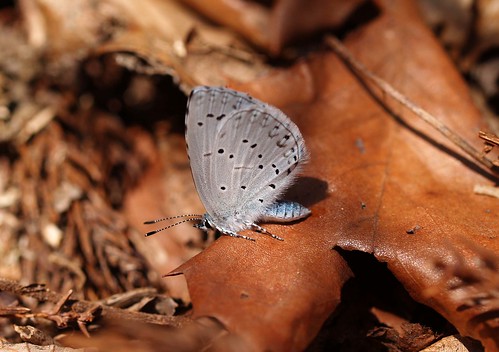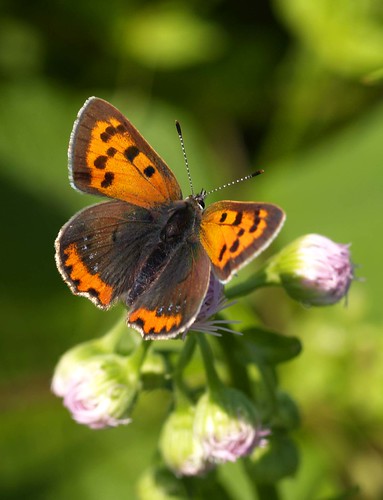Wednesday, May 31, 2006
Teaching English in Iwate in 1963
I'm collecting old newspaper clippings about Iwate on Iwate Buddy. So far I have 52 articles spanning the years from 1891 to the present! There is a handy-dandy index page with a list of all the titles, dates and keywords that is quite useful. Here is an excerpt from the latest addition.
AMERICAN GAGS FALL FLAT
Another Report on Japan from Teacher John Miles
Here is a second article by John Miles, member of the Pierce College English department who holds a Fulbright scholarship and is teaching in Japan. In this one he writes about the Japanese idea of humor, their women as compared to ours, the accommodations for Olympic Games visitors, and the cormorant fishing spectacle.
By JOHN MILES
Remember the little cards of advice, THIMK and THINK AHEAd, or the lady who couldn't get all of HAPPY BIRTHDAY on the cake so she finished on Cupcakes? Nothing has fallen so flat in my Japanese class as these gags.
But a student's statement his English was so poor even the ash trays were laughing had 'cm rolling in the aisles. Sometimes I truly think that never the twain shall meet.
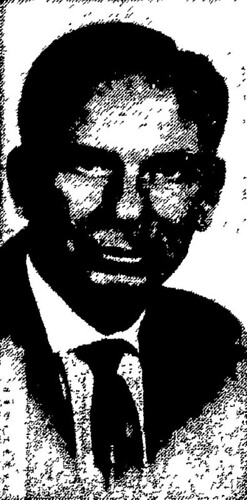
[John Miles]
HANAMAKI TOWN — We’ve just returned to Tokyo, the world's most frantic city, from bitterly cold Hanamaki Town. This is up north near Morioka, capital of Iwate Prefecture, where they still affectionately remember Pierce College President John Shepard. He was in charge of occupational forces there after the war.
Sent by the Fulbright Commission, our job was to do what we could, in five days, for Japanese teachers of English, some of whom had never before seen or heard an American.
I don’t think we did anybody any good. We might have in five weeks or five months.
Between classes we three products of the city carried on a life-and-death struggle to be nearest the hibachi, while outside old men and women plowed their fields, and children played unmindful of the blizzard. Iwate Prefecture is known as the poorest in Japan. Maybe the rest of us could use a little of their "poverty."
Jump to the entire article here!
AMERICAN GAGS FALL FLAT
Another Report on Japan from Teacher John Miles
Here is a second article by John Miles, member of the Pierce College English department who holds a Fulbright scholarship and is teaching in Japan. In this one he writes about the Japanese idea of humor, their women as compared to ours, the accommodations for Olympic Games visitors, and the cormorant fishing spectacle.
By JOHN MILES
Remember the little cards of advice, THIMK and THINK AHEAd, or the lady who couldn't get all of HAPPY BIRTHDAY on the cake so she finished on Cupcakes? Nothing has fallen so flat in my Japanese class as these gags.
But a student's statement his English was so poor even the ash trays were laughing had 'cm rolling in the aisles. Sometimes I truly think that never the twain shall meet.

[John Miles]
HANAMAKI TOWN — We’ve just returned to Tokyo, the world's most frantic city, from bitterly cold Hanamaki Town. This is up north near Morioka, capital of Iwate Prefecture, where they still affectionately remember Pierce College President John Shepard. He was in charge of occupational forces there after the war.
Sent by the Fulbright Commission, our job was to do what we could, in five days, for Japanese teachers of English, some of whom had never before seen or heard an American.
I don’t think we did anybody any good. We might have in five weeks or five months.
Between classes we three products of the city carried on a life-and-death struggle to be nearest the hibachi, while outside old men and women plowed their fields, and children played unmindful of the blizzard. Iwate Prefecture is known as the poorest in Japan. Maybe the rest of us could use a little of their "poverty."
Jump to the entire article here!
White Lies
I've been teaching English in Japan for something like 14 years now, for four different companies large, small and medium, and for myself. One of the things I've noticed consistently is that if anything goes wrong the foreign teacher takes the blame. Sometimes the foreign teacher really is to blame but just as often she is not. The all purpose excuse of Eikaiwa? "So sorry, your teacher got sick!"
One shimmering white butterfly lighting on your finger is charming. Two or three are enchanting. Hundreds and thousands are crushing.
One shimmering white butterfly lighting on your finger is charming. Two or three are enchanting. Hundreds and thousands are crushing.
Tuesday, May 30, 2006
Winter's wrath
From the Asahi News
MORIOKA: Winter's wrath leaves costly road damage
05/09/2006
Last winter's record snowfalls have left more than a chilly memory for drivers in the country's colder climes. The unrelenting ice and snow caused moisture to penetrate below asphalt road surfaces, freeze and push up cracks at about 1,500 points on highways in Iwate prefecture. And more bumps in the roads are likely to emerge when the accumulated snow completely melts, Iwate Prefecture officials said.
On top of the damage, February's warmer temperatures may have put the chances of qualifying for government assistance on ice. Iwate Prefecture has asked the central government to label the situation a natural disaster, which would free up central government funding to repair roads, officials said. Otherwise, prefectural and municipal governments will have to dole out more than 10 billion yen for repairs, they added.
According to the prefecture's sediment control and disaster-prevention division, the damaged spots are on asphalt roads under the various jurisdictions of central, prefectural and municipal governments. Road officials expect to find even more damage after routes that were closed for the winter reopen, adding to the repaving and repair bill.
After the 2000-01 winter season, the cost to fix 2,291 damaged spots on the prefecture's roads was 26.5 billion yen. The snowfall was so great that the central government called it a natural disaster and paid two-thirds of the repair cost, covering the remainder with local tax grants. Under government rules, for ice damage to qualify as a natural disaster, the winter must be the coldest in the past 10 years. But this year, the temperature began to rise in early February, meaning the average temperature was not as low as in 2001, prefectural officials said.
The prefecture reported the damage to the Ministry of Land, Infrastructure and Transport anyway, hoping to qualify for disaster-relief funding. Their chances are thin, officials admit. Yet, without central government aid, prefectural and municipal governments will have trouble paying for all road repairs. The cost could soar to over 10 billion yen, with some estimates at tens of billions of yen, given that repairs cost 26.5 billion yen in 2001, officials said. The prefectural government set aside 1.14 billion yen for road maintenance and repairs in its initial fiscal 2006 budget, based on a forecast from last September.
The extreme cold that hit was completely unexpected, the officials said.
In Morioka, the city government found 19 places on roads in its jurisdiction that need repaving--to the tune of about 220 million yen. However, Morioka allocated only 240 million yen for regular road maintenance projects in its budget for fiscal 2006. Repairing the winter's damage will erode most of that, leaving little for other repairs unless the city government passes a supplementary budget.
According to the Tohoku branch of the East Nippon Expressway Co., the privatized entity that runs the region's highways, 75 frost-damaged spots along roads in Morioka and Kitakami required repairs. "There was a lot of damage, and we've never seen anything like this," an official said, adding the repairs were done by the end of March.
(IHT/Asahi: May 9, 2006)
[Imagine if they took the potholes in YOUR neighborhood this seriously!]
MORIOKA: Winter's wrath leaves costly road damage
05/09/2006
Last winter's record snowfalls have left more than a chilly memory for drivers in the country's colder climes. The unrelenting ice and snow caused moisture to penetrate below asphalt road surfaces, freeze and push up cracks at about 1,500 points on highways in Iwate prefecture. And more bumps in the roads are likely to emerge when the accumulated snow completely melts, Iwate Prefecture officials said.
On top of the damage, February's warmer temperatures may have put the chances of qualifying for government assistance on ice. Iwate Prefecture has asked the central government to label the situation a natural disaster, which would free up central government funding to repair roads, officials said. Otherwise, prefectural and municipal governments will have to dole out more than 10 billion yen for repairs, they added.
According to the prefecture's sediment control and disaster-prevention division, the damaged spots are on asphalt roads under the various jurisdictions of central, prefectural and municipal governments. Road officials expect to find even more damage after routes that were closed for the winter reopen, adding to the repaving and repair bill.
After the 2000-01 winter season, the cost to fix 2,291 damaged spots on the prefecture's roads was 26.5 billion yen. The snowfall was so great that the central government called it a natural disaster and paid two-thirds of the repair cost, covering the remainder with local tax grants. Under government rules, for ice damage to qualify as a natural disaster, the winter must be the coldest in the past 10 years. But this year, the temperature began to rise in early February, meaning the average temperature was not as low as in 2001, prefectural officials said.
The prefecture reported the damage to the Ministry of Land, Infrastructure and Transport anyway, hoping to qualify for disaster-relief funding. Their chances are thin, officials admit. Yet, without central government aid, prefectural and municipal governments will have trouble paying for all road repairs. The cost could soar to over 10 billion yen, with some estimates at tens of billions of yen, given that repairs cost 26.5 billion yen in 2001, officials said. The prefectural government set aside 1.14 billion yen for road maintenance and repairs in its initial fiscal 2006 budget, based on a forecast from last September.
The extreme cold that hit was completely unexpected, the officials said.
In Morioka, the city government found 19 places on roads in its jurisdiction that need repaving--to the tune of about 220 million yen. However, Morioka allocated only 240 million yen for regular road maintenance projects in its budget for fiscal 2006. Repairing the winter's damage will erode most of that, leaving little for other repairs unless the city government passes a supplementary budget.
According to the Tohoku branch of the East Nippon Expressway Co., the privatized entity that runs the region's highways, 75 frost-damaged spots along roads in Morioka and Kitakami required repairs. "There was a lot of damage, and we've never seen anything like this," an official said, adding the repairs were done by the end of March.
(IHT/Asahi: May 9, 2006)
[Imagine if they took the potholes in YOUR neighborhood this seriously!]
Princess Centipede :: ムカデの姫
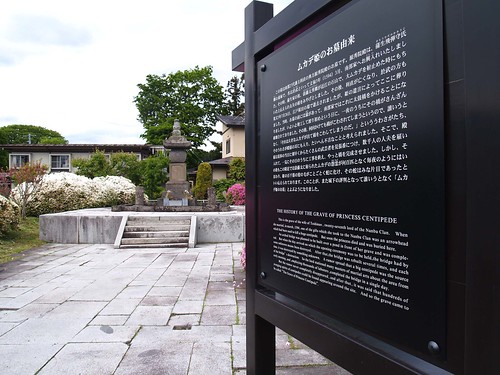
[The grave of Princess Centipede with the sign]
The grave of princess Centipede is located in Morioka City in Nasukawa-cho. The stones making up the current grave do not at all appear to be in their original configuration. Some of the stones and inscriptions appear to be newish while others seem quite old. I could easily imagine that at one time there was quite an assemblage of elegant shrines, temples, gardens and whatnot here. But then an earthquake or other disaster knocked them down and jumbled the stones together in hopeless confusion. What to do! One solution would be to gather a group of small boys together and tell them to gather all the stones together and make whatever they want!

[The grave with Koudai-ji in the background]
The story of the grave reads as follows from the sign -
THE HISTORY OF THE GRAVE OF PRINCESS CENTIPEDE
This is the grave of the wife of Toshinao, twenty-seventh lord of the Nanbu Clan. When she married in March 1594, one of the gifts which she took to the Nanbu Clan was an arrowhead which had been used to kill a huge centipede. But soon the princess died and was buried here.
An arched bridge was planned to be built over a pond in front of her grave and was completed. But when the day arrived on which the opening ceremony was to be held, the bridge had, by some unknown means, been destroyed. After that the bridge was rebuilt several times and each time it was destroyed by something unknown. A rumor spread that a big centipede was the source of the bridge's destruction. So the lord stationed many masters of martial arts about the area from early morning and employing thousands of laborers completed the bridge in a single day.
But the rumor never completely disappeared, and after that it was said that hundreds of avenging spirits of centipedes could be seen appearing around the site. And so the grave came to be called, "The grave of Princess Centipede."
:: :: ::
I have heard that this same story, or one similar to it, occurs in other places around the world. Whatever the case may be, I think Hayao Miyazaki must have known this story and used it for the opening sequence of his movie "Princess Mononoke."
The Japanese story on the same sign seems to be a bit longer and contain some differences. For one thing I noticed a snake in it down near the end. I will try and translate it and report back!
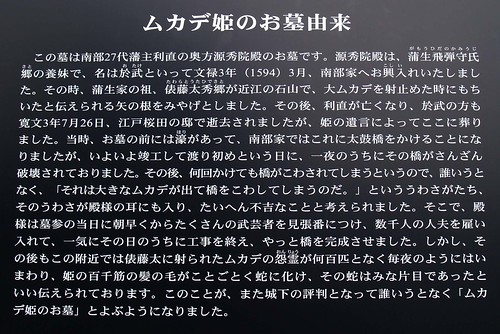
[The text in Japanese - click to see larger versions]
光台寺 :: こうだいじ :: Koudai-ji
盛岡市 :: Morioka City
名須川町八ー四 :: Nasukawa-cho 4-8
This temple was established in 1573 and belongs to the Pure Land Sect of Buddhism.
Monday, May 29, 2006
On Eating Wild Plants

[Angelica Tree Bud - タラノメ - Aralia elata]
Every Spring hordes of people head for the hills to gather various kinds of wild plants to take home and eat. There are enough varieties to fill a book but this year I gathered only three; Angelica tree buds, butterbur sprouts and bamboo shoots.
Angelica Tree (or Fatsia) buds - タラノメ - Aralia elata
butterbur (or coltsfoot) sprouts - フキノトウ - Petasites japonicus
bamboo shoots - チシマザサ or ネマガリタケ - Sasa kurilensis
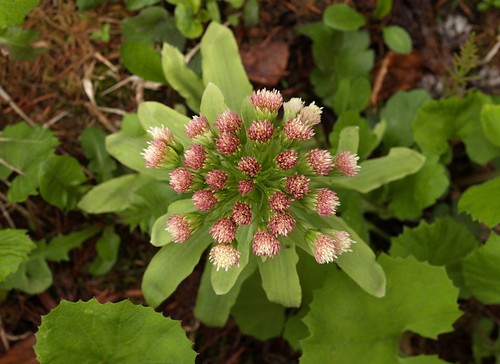
[butterbur - フキ - Petasites japonicus; too mature to eat!]
The Angelica tree buds and the butterbur can be boiled or fried as tempura. They are a bit bitter but leave a clean refreshing aftertaste. The bamboo shoots are very tender and can be eaten raw as they are picked. Dipped in mayonaise they are good too. Another way to prepare them is to steam or barbecue them. Thay are delicious no matter what you do to them.
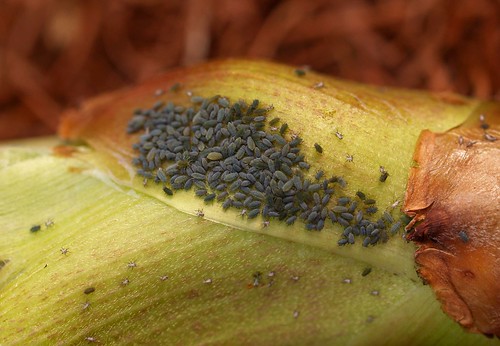
[Angelica Tree Bud infested with aphids]
Watch out for bugs, though, whenever you are harvesting wild veggies! We picked most of our butterbur sprouts on May second near Geto in Kitakami but it was almost too late. It would have been better to get them a week or two earlier. My wife told me not to get the ones next to the road. I thought she was worried about all the car exhaust but it turns out she was more worried about the people who stopped to relieve themselves along the side of the road!
MyVitaminGuide.com has an interesting account of the benefits of eating butterbur. Apparently it is effective in relieving allergies, hay fever and migraine headaches. Prevention.com also has a page on this. There are a few recipes online such as this one from Yasuko-san's Home Cooking!
You can go to the Iwate Buddy's website to see a picture of bamboo being barbecued at the Maesawa Beef Festival! There is also another picture here from the 2004 festival! We will be there again this next weekend, June 4, 2006.
Sunday, May 28, 2006
Shiwa :: 紫波
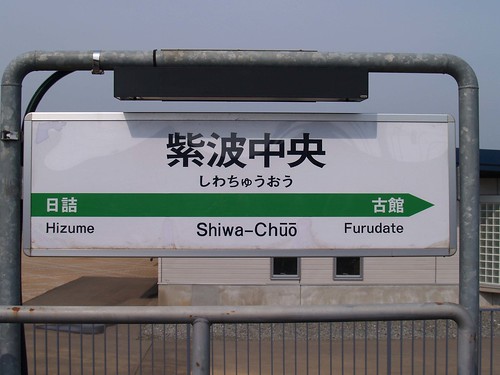
[Shiwa Chuo train station sign]
Today Shiwa is a small town in central Iwate just South of Morioka. It has been a wonderful garden paradise but is now rapidly transforming itself into a sprawling suburb of Morioka. It still ranks number one in the nation in the production of Mochi Rice and number one in the prefecture in the production of grapes, apples and pears!

[Shiwa grapes]
The name Shiwa is very old and comes from the Emishi people who lived there before the Japanese took over. The first official Japanese settlement in this area was Fort Shiwa in what is now Morioka. It dates from 804. But before this fort was established, Emperor Kammu (782 - 806) declared all the lands of Honshu his and all the inhabitants thereof his as well! He then had maps drawn and names put on all the lands. The land of the Shiwa Emishi was designated Shiwa County before ever the Yamato army had conquered it!
The first Chinese characters that were used to write this Emishi name were -
(type 1) 子波 as in 子波郡 [Shiwa County]
The characters could be translated as 'CHILD + WAVE' where 'wave' refers to the movement of water and not of hands!
Then, in 804, Fort Shiwa was built and the Shiwa Road was opened from Fort Isawa to Fort Shiwa. For this different Chinese characters were used -
(type 2) 志波 as in 志波街道 [Shiwa Road]
and 志波城 [Fort Shiwa]
This new character gives the fort a more military feel I suppose. It can be rendered as 'AMBITION + WAVES'
Next, in 811, the spelling of Shiwa County was changed to -
(type 3) 斯波 as in 斯波郡 [Shiwa County]
These are also the same characters a local military hero, Ienaga Shiwa used to spell his name. He died at the tender age of 17 in 1339. This new Chinese character is now obsolete. It was used in words with meanings like 'thus' and 'so'!
A new pairing of Chinese characters were used when the local Inari Shinto Shrine was established in 1057 -
(type 4) 志和 as in 志和稲荷神社 [Shiwa Inari Jinja]
These characters might be translated as 'AMBITION + PEACE'. One wonders if the Shinto priests were encouraging a new attitude! Much later, in 1591, Shiwa County again changed the way it's name was written, copying the shrine's name. There is also a small area (not a village, town, city or county), in the West of present day Shiwa Town that was created at the same time and still exists with this same spelling!
A look at any modern day map of the area will show that the name of the present city, several schools and the train station use still a different Chinese character -
(type 5) 紫波 as in 紫波町 [Shiwa Town]
Here the characters can be translated 'PURPLE + WAVES' which are thought to refer to the waves on the Kitakami River! I am told that the elementary school's song makes reference to this.
So, there are five ways at least to write Shiwa, four of which can still be found in use in Shiwa Town today.
Shiwa Town has a Japanese language home page here.
Saturday, May 27, 2006
The Battle of Sufuse Village
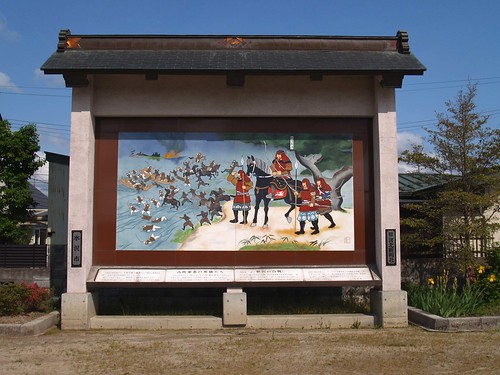
[The Battle of Sufuse Village in a park in Mizusawa]
North America has it's "Wild West" full of high drama, adventure, violence, gold and larger-than-life heroes. These included cowboys, outlaws, explorers, priests, soldiers and Indians, to name just a few. We learned about them from our earliest childhood as they alternately committed crimes and righted wrongs over and over again on the big screen and in paperback novels. In much the same way Japan had its own "Wild West" about 1,000 years earlier than North America!
Northeast Japan, or Tohoku, was inhabited by a group of people called the Ezo or Emishi. They may or may not have been related to the peoples who came before, the Jomon, or the ones that came after, the Ainu and the Yamato. (The Yamato were the people we now call the Japanese.) These Emishi led what might be called a fairly simple life of hunting, gathering and farming. They lived in small villages which in turn made up larger groups like the tribes or nations found in North America. Two of the strongest groups were in the area that is now Iwate; the Shiwa and the Isawa.
The Isawa Emishi seem to have dwelt along the Kitakami River in an area from the Koromo River in the South to perhaps the Waga River in the North; roughly the area encompassed by present day Oshu City and Kanegasaki Town. What is now Mizusawa Ward of Oshu City was then the heart of Isawa territory and this is where it's greatest leader and hero, Aterui, lived. Unfortunate;y we can only know about him from his enemy, the Yamato, as the Emishi themselves left no written records!
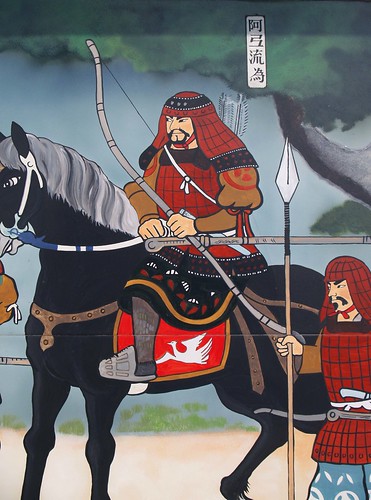
[Aterui on horseback]
The 8th century saw numerous Yamato expeditions against the Emishi which all ended in defeat and humiliation for the Emperor. In 776 two separate attacks were launched against the Isawa and Shiwa Emishi. The first, in February, employed 20,000 troops in a surprise attack over the Ou Mountains that was neither. It was not a surprise and the heavy Yamato infantry couldn't catch the quick moving Emishi cavalry to attack them! They finally went home in May having accomplished nothing.
Ten years later, in 786, a certain Ki no Asami Kosami was appointed the new General of Eastern Conquest. He already held several important positions in the government including Councilor of the Cabinet, Secretary of the East Palace and Middle General of the Interior Guard. Unfortunately none of these seem to have prepared him much for a long military campaign in the field against a determined foe! Nevertheless he led a force of some 52,800 persons out of Fort Taga, near present day Sendai in Miyagi Prefecture, in the Spring of 789.
This force crossed the Koromo River into Isawa territory on March 28th and made their camp in the plains where the Koromo meets the Kitakami. There they rested for some three months before finally launching an attack in June. The Yamato army consisted of some 4,000 soldiers in three armies. The Center and Rear armies crossed the Kitakami while the Front Army remained on the West side of the river. Then they headed North on each side of the Kitakami burning crops and villages as they went. Their plan was to meet up at Sufuse Village where the Front Army would cross the Kitakami, join the other two armies and attack the Isawa Emishi.
A group of about 300 Emishi attacked the Front Army as the proceeded North but were easily repulsed. They were, however, strong enough to prevent the Front Army from crossing the Kitakami. The Center and Rear armies were attacked by about 800 Emishi in the front and stopped their advance. As they were falling back another Emishi force of 400 troops arrived from Higashiyama attacking their rear. The Emishi killed five of seven commanders and 25 soldiers with their arrows and wounded another 245. The Yamato armies on the East side of the Kitakami were pushed into the river by the superior firepower of the Emishi who swept down from the hills on horseback. In the river another 1,036 soldiers drowned while another 1,257 lost their armor according to General Ki no Asami Kosami's report. The Emishi were reported to have lost 89 dead, but 14 villages and about 800 houses were burned along with crops and farm machinery.
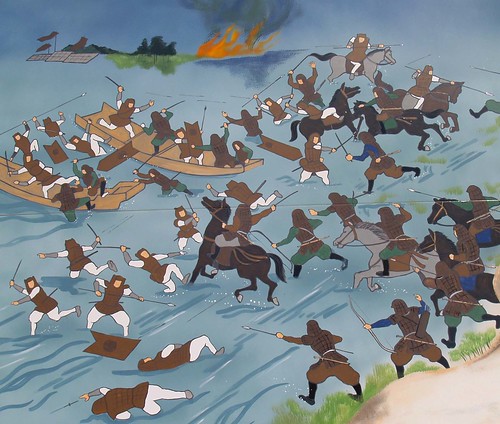
[The Emishi driving the Yamato into the Kitakami River]
On September 8th General Ki returned to the capital where he was rebuked by the emperor. It seems that the general and his four vice generals had not led their troops into battle! They had remained in camp and entrusted the entire operation to their commanders! Aterui had won the battle but he was not strong enough to follow up this victory by attacking the Yamato in their own territory. He himself surrendered to the Imperial forces a few years later allowing the Emperor to build a line of forts up the Kitakami Valley and posses it as his own land. This was the last full scale battle between the Emishi and the Yamato.
Much of this account comes from the excelent material on Suzutayu's wonderful web site the Conquest of Emishi. I highly recommend it for further study. There is another useful site about Aterui on the Unveiling Histories of the Tohoku District web site by Eishiro Ito.
Friday, May 26, 2006
Radio Morioka

[Kayoko Takahashi of Radio Morioka]
Radio Morioka has a WEB SITE in Japanese with a link in the upper left hand corner to listen to live broadcasts. They don't do this 24/7 but give it a whirl today and you might get lucky! There is a handy links section too with a listing of other stations in the Tohoku area.
There is also a BLOG in Japanese so you can keep up with the latest happenings.
Wikipedia even has a page on Radio Morioka, in Japanese only.
Thursday, May 25, 2006
Yamada and Holland Island
As part of my Iwate Buddy website I'm writing a blurb about each city, town and village in Iwate. The first one is about Yamada Town and here is a rough first draft!
Y A M A D A
T O W N
O N
I W A T E
B U D D Y

[a large fish at Holland Island]
Yamada is a remote port town of around 20,000 people nestled deep in the heart of the Rikuchuu Seashore National Park. It is composed almost entirely of mountains which rise as high as 1,160 meters in the West and drop down to the sea on the Eastern seaboard in sheer cliffs dozens of meters high in some places.
It is connected to the outside world by National Highway 45 and the JR Yamada Rail line. Both of which run North (to Miyako) and South (to Kamaishi) along the coast. There are no roads leading west, no passenger boats heading west and there is no airport!
The locals mainly occupy themselves with fishing and shipping, raising shellfish (oysters and scallops mostly) and a bit of farming (rice for the most part, but also gentians, lettuce, spinach and shiitake mushrooms). Which is to say they are bored stiff and the young people flee as quickly as they can and as far as they are able! But all of this combines to make Yamada a near paradise for the vacationing visitor!
The coastline is spectacular! There are back roads that wind along the coast providing wonderful scenic views; mountains with streams gushing down their sides to the sea below creating breathtaking waterfalls; a beach or two and campgrounds for the adventurous. Then there is the jewel of Yamada - Holland Island. It is tiny and you can only get there by boat for a month or two in the summer, but it is worth going out of your way for!
Holland Island has no electricity, running water or any of the modern conveniences that clutter our daily lives! There is a dock for the boat, a restroom, a small food stall selling cold drinks and snacks, and a sandy beach. The water is clear and clean and full of fish, eels, crabs and more. You will want to snorkel here all day!
The Island received it's name after a Dutch ship stopped here on July 29, 1643, the Breskence (pardon my spelling!). The story that has been told for a long time is that the ship stopped here looking for food and water. At that time the country was closed to foreigners but the locals let them stay on the island. It is now known that the ship was part of a larger fleet cruising the coast of Hokkaido and Honshu looking for gold!
The Breskence (pardon my spelling!) stopped again a few years later and the captain boldly came ashore with his officers! They were arrested and brought to Morioka castle with their hands tied. Lord Nanbu sent a messenger to Edo (Tokyo) with the news and a query as to what he should do with them. At that time they used a relay system a bit like the pony express of America's wild West - only there were no ponies! They used human runners!
The Shogun asked that they be delivered to him and they were.The shogun supposed they were here to spread Christianity and interrogated them for weeks. Finally convinced that they were merely harmless treasure seekers he released them to the Dutch community in Nagasaki. The captain returned home and wrote an account of his experiences which still survives.
JAPANESE LINKS
Yamada Town has it's own home page.
Fureai Park is a fun place to visit.
Wikipedia has some information
The Geographical Survey Institute provides access to it's high quality topographic maps
Y A M A D A
T O W N
O N
I W A T E
B U D D Y

[a large fish at Holland Island]
Yamada is a remote port town of around 20,000 people nestled deep in the heart of the Rikuchuu Seashore National Park. It is composed almost entirely of mountains which rise as high as 1,160 meters in the West and drop down to the sea on the Eastern seaboard in sheer cliffs dozens of meters high in some places.
It is connected to the outside world by National Highway 45 and the JR Yamada Rail line. Both of which run North (to Miyako) and South (to Kamaishi) along the coast. There are no roads leading west, no passenger boats heading west and there is no airport!
The locals mainly occupy themselves with fishing and shipping, raising shellfish (oysters and scallops mostly) and a bit of farming (rice for the most part, but also gentians, lettuce, spinach and shiitake mushrooms). Which is to say they are bored stiff and the young people flee as quickly as they can and as far as they are able! But all of this combines to make Yamada a near paradise for the vacationing visitor!
The coastline is spectacular! There are back roads that wind along the coast providing wonderful scenic views; mountains with streams gushing down their sides to the sea below creating breathtaking waterfalls; a beach or two and campgrounds for the adventurous. Then there is the jewel of Yamada - Holland Island. It is tiny and you can only get there by boat for a month or two in the summer, but it is worth going out of your way for!
Holland Island has no electricity, running water or any of the modern conveniences that clutter our daily lives! There is a dock for the boat, a restroom, a small food stall selling cold drinks and snacks, and a sandy beach. The water is clear and clean and full of fish, eels, crabs and more. You will want to snorkel here all day!
The Island received it's name after a Dutch ship stopped here on July 29, 1643, the Breskence (pardon my spelling!). The story that has been told for a long time is that the ship stopped here looking for food and water. At that time the country was closed to foreigners but the locals let them stay on the island. It is now known that the ship was part of a larger fleet cruising the coast of Hokkaido and Honshu looking for gold!
The Breskence (pardon my spelling!) stopped again a few years later and the captain boldly came ashore with his officers! They were arrested and brought to Morioka castle with their hands tied. Lord Nanbu sent a messenger to Edo (Tokyo) with the news and a query as to what he should do with them. At that time they used a relay system a bit like the pony express of America's wild West - only there were no ponies! They used human runners!
The Shogun asked that they be delivered to him and they were.The shogun supposed they were here to spread Christianity and interrogated them for weeks. Finally convinced that they were merely harmless treasure seekers he released them to the Dutch community in Nagasaki. The captain returned home and wrote an account of his experiences which still survives.
JAPANESE LINKS
Yamada Town has it's own home page.
Fureai Park is a fun place to visit.
Wikipedia has some information
The Geographical Survey Institute provides access to it's high quality topographic maps

